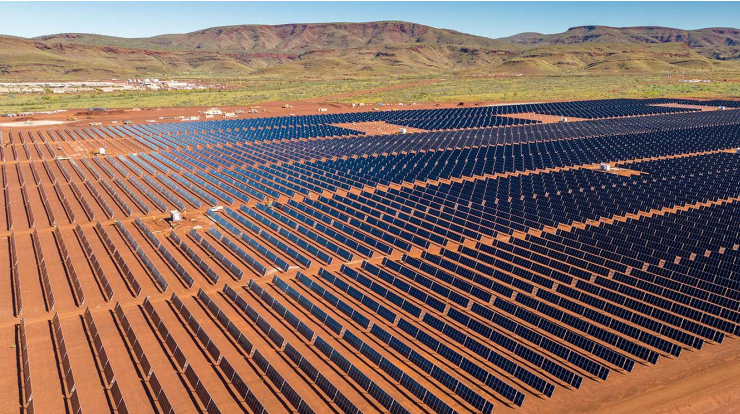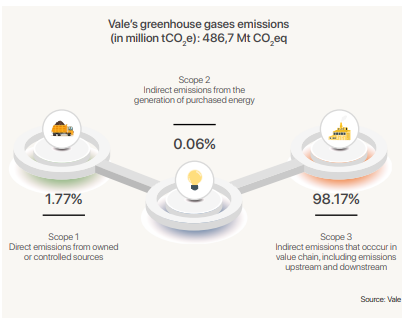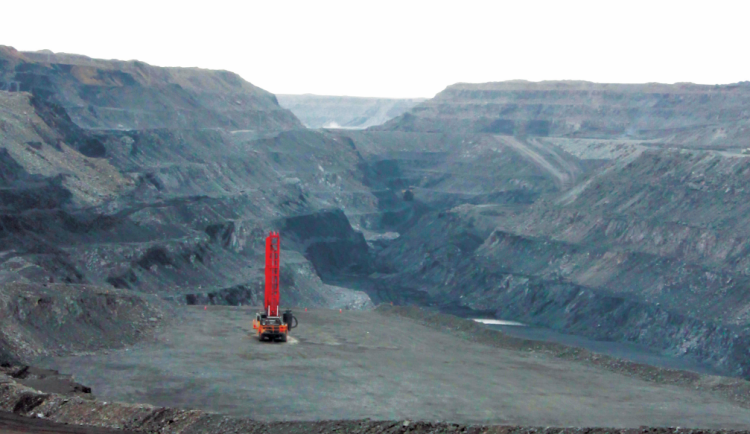 MISHEEL. E
MISHEEL. EThe global spotlight on greenhouse gases has intensified, prompting countries to make significant commitments to reduce emissions in alignment with their unique characteristics. Over 140 countries, comprising major emitters like the United States, China, the Republic of Moldova, and the European Union, collectively responsible for 88 percent of total emissions, have pledged towards achieving the net-zero goal. Beyond nations, the United Nations reports that over 9,000 companies have also committed to reducing carbon emissions. Notably, leading mining companies worldwide have incorporated calculations of greenhouse gas emissions into their annual financial statements, articulating clear net-zero objectives. A discernible correlation exists between a company's greenhouse gas report, its reputation, valuation, and revenue. In essence, the commitment to and reporting of zero carbon emissions has evolved into an irreversible global trend. Therefore, we present an overview of the greenhouse gas emissions from major foreign and domestic mining companies, along with an exploration of Mongolia's policies on greenhouse gases.
A thorough reporting of carbon dioxide emissions significantly impacts a company's reputation
According to GlobalData, the mining and metals industry is projected to contribute 1.5-2.6 billion tonnes of global greenhouse gas emissions by 2021, constituting approximately 4-7 percent of total emissions. Among these, the top 10 companies are responsible for 2.4 billion tonnes, with over half attributed to three companies within the top five by market capitalization: Rio Tinto, Vale S.A., and BHP. It's crucial to note that the calculation of carbon dioxide emissions includes not only the activities occurring directly at the mine but also the CO2 e emissions from aborating comp. For instance, out of Vale S.A.'s 486.7 million tonnes of CO2 emissions, the "Scope 1 and 2" emissions from all stages of operations, equipment, electricity, and heat within its own mines constitute 1.83 percent of the total. The remaining 98.17 percent, equivalent to 477.8 million tonnes, is associated with carbon emissions generated by companies involved in purchasing and processing mining products, along with those cooperating in the value chain. The assessment of "Scope 3" extends to include emissions resulting from various activities, such as the transportation of employees via non-company public transportation and airplanes. As per the Kyoto Protocol, greenhouse gases contributing to global warming encompass carbon dioxide, methane, nitrogen oxides, sulfur hexafluoride, hydrofluorocarbons, and perfluorocarbons. Under this protocol, each gas is assessed, and greenhouse gas emissions are quantified in terms of carbon dioxide equivalent (CO2 e). The protocol holds international significance. Among the six gases, sulfur hexafluoride, hydrofluorocarbons, and perfluorocarbons are anthropogenic, originating from human activities. In contrast, carbon dioxide, methane, and nitrogen oxides occur naturally as components of solid fuels like coal, oil, and natural gas. Human activities involve the extraction and utilization of fossil fuels in daily life. To mitigate these activities, restrictions on fuel combustion have been established. In nature, carbon dioxide, methane, and nitrogen oxides also emanate from volcanic eruptions, forest fires, animal carcasses, excrement, soil, and swamps.
The top three mining companies have successfully reduced carbon dioxide emissions by 8.2 million tonnes
In the previous year, Rio Tinto recorded emissions of 30.3 million tonnes of CO2 e from Scope 1 and 2, marking a decrease of 3.4 million tonnes compared to 2018. To provide context, this reduction is equivalent to the annual emissions of 740,000 typical passenger cars. Approximately two-thirds of the total emissions were linked to aluminum production, with copper production contributing the least at 1.5 million tonnes.

The group is actively pursuing sustainability measures, initiating four solar and wind projects to power operations, particularly in aluminum, iron, and titanium mines, known for their significant greenhouse gas impacts. For instance, the Pilbara iron ore group in Western Australia aims to supply 234 MW of solar energy starting in 2026. The company is also engaged in renewable energy projects in Queensland, Australia, Madagascar, and South Africa. Diesel fuel accounts for 13 percent of Rio Tinto's CO2e, equivalent to 3.9 million tonnes. In a bid to reduce this carbon footprint, the first boron mine in California, USA, has transitioned to using biodiesel fuel—an unprecedented move in an open-pit mine. This shift is expected to divert up to 45,000 tonnes of diesel fuel consumption annually. Rio Tinto's overarching strategy involves achieving a 15 percent reduction in carbon emissions by 2025, a 50 percent reduction by 2030, and net-zero emissions by 2050.

Vale S.A.: The corporation aims to reduce Scope 1 and 2 emissions by 33 percent in 2030 compared to 2017. Plans include achieving zero emissions from electricity in Brazil by 2025 and globally by 2030, transitioning entirely to renewable energy. Notably, emissions from Scope 1 and 2 were already reduced by 1.2 million tonnes within four years. The company utilized 1 million tonnes of diesel fuel for railways and trucks, with potential solutions being explored, such as hydrogen for railways, ammonia and ethanol for trucks. Vale Corporation aspires to attain net-zero CO2 e emissions from its operations by 2050. Carbon emissions from BHP Billiton's Scope 1 and 2 experienced a reduction of 3.6 million tonnes over three years, reaching 12.3 million CO2 e last year. The group is actively transitioning to renewable energy, exemplified by the Escondida and Spence copper mines in Chile, which will be powered by 90-100 percent renewable energy from 2026. Agreements with Chile's Colbun S.A. and Italy's Enel spanning 10-15 years were established for this purpose. Furthermore, seven agreements were signed to supply nickel and iron ore mines with renewable energy, aiming to provide 24-48 percent of the mines' electricity from clean energy by 2026. Recognizing that around 40% of the group's greenhouse gas emissions arise from diesel fuel consumption, the Pilbara iron ore mine is testing biodiesel in trucks, marking a transition until complete electrification. "BHP Group" has set two goals for reducing greenhouse gas emissions from "Scope 1 and 2." The first objective is to achieve a minimum 30 percent reduction by 2030 compared to 2020, with the subsequent goal of reaching net zero by 2050.
Mongolian mining companies calculate their carbon dioxide emissions
Oyutolgoi LLC is among the companies actively calculating greenhouse gas emissions. In the past year, the company emitted 1.22 million tonnes of CO2 in Scope 1 and 2. Notably, Scope 2 emissions, stemming from electricity consumption, exceeded 0.9 million tonnes, with 68 percent of electricity being allocated to beneficiation production. The company fulfills 100% of its electricity needs through a contract with the "Inner Mongolia Energy International Cooperation" Corporation of China. Presently, the Oyutolgoi mine consumes 180 MW at its peak, with an anticipated increase to 250 MW when the underground mine reaches full capacity. However, approximately 79 percent of the emissions, around 0.3 million tonnes in Scope 1, are linked to diesel fuel used in open-pit mining. Additionally, a thermal power plant in the mine area consumes over 40,000 tonnes of coal annually, and efforts are underway to reduce this greenhouse gas emission through the introduction of new technologies. Oyutolgoi LLC aims to progressively reduce carbon emissions to 30% in 2025, and 50% in 2030, and achieve net-zero emissions by 2050. The company's methodology for calculating greenhouse gases aligns with that of Rio Tinto. Erdenet Mining Corporation SOE has previously conducted CO2 emissions calculations. In 2013, a collaborative study with the then Ministry of Environment and Green Development and the World Bank revealed emissions exceeding 1 million tonnes during operations. Since then, the installed capacity of thermal power plants has increased from 35 MW to 71 MW in 2021. Last year, Erdenet TPP emitted 0.77 million tonnes of CO2 . With the construction of a million-tonne copper smelter in the pipeline, energy consumption is expected to rise in the future. Energy Resources LLC meticulously calculates greenhouse gas emissions across three levels and production. The 2019 report introduced a new definition for the amount of greenhouse gases emitted from sources falling under "Scope 3."
In the recent 2022 disclosure, Energy Resources LLC reported emissions of 634,000 tonnes in "Levels 1 and 2" and 12.59 million tonnes in "Level 3," totaling over 13.2 million tonnes.
Additionally, last year's report indicated the release of 4.2 million tonnes in production. The company has enhanced the precision of its greenhouse gas emission calculations for the year 2022. In 2011, Energy Resources commissioned an 18 MW power plant.
Note: Each company employs different methods for calculating greenhouse gases,
and the classification as "Scope 1, 2, and 3" may vary despite the differences in nomenclature.
Mongolian and Brazilian mining companies to plant trees
Mongolia has made an international commitment to enhance greenhouse gas absorption and combat climate change through the "Billion Trees" national movement, initiated in 2021. As of 2023, approximately 20 mining companies have joined this movement, collectively planting 4.1 million trees last year with plans to exceed 9 million tree plantations this year. The question arises: does tree planting effectively contribute to reducing greenhouse gases, especially in the context of mining companies? According to Carbonfund.org, a research organization based in New York, planting trees is indeed an impactful strategy to mitigate the environmental footprint of electricity generated from fossil fuels. The organization has determined that consuming 1,000 kWh of electricity is equivalent to the positive impact of 7.2 trees grown for 10 years. This implies that mining companies have the potential to offset greenhouse gas emissions resulting from fuel combustion by actively engaging in treeplanting initiatives. Various research organizations concur that there exist multiple avenues to curb carbon emissions. These include conserving electricity and heat, boosting renewable energy production, minimizing food and household waste, adopting low-carbonemission vehicles, implementing emission-reducing technologies in industries, and, notably, planting trees. In essence, to maintain a balance in human-induced greenhouse gas emissions, and prevent an increase in carbon dioxide emitters, tree planting stands out as a highly optimal and straightforward approach. Vale S.A., ranked as the world's third-largest mining company by market capitalization, announced its commitment to tree planting last year. Collaborating with other companies, Vale S.A. aims to plant two million trees in Brazil, with an initial fundraising round targeting USD 5 million. This initiative seeks to restore 2 million hectares of degraded land, aligning with Brazil's afforestation policy and the goals outlined in the Paris Agreement to reduce greenhouse gas emissions by 2030.
Countries worldwide respond to greenhouse gas emissions based on their unique characteristics. While developed nations with advanced technology have shifted towards electric vehicles, supported renewable energy, and invested in zero-emission technologies, Mongolia has initiated a national movement to plant a billion trees. Additionally, through the implementation of the "National Adaptation Plan" since last year, Mongolia aims to bridge the gap between greenhouse gas emissions and absorption by 2050. Over 100 countries, including Mongolia, pledged to the "Global Methane Pledge" at the COP26 meeting in Glasgow in 2021. Mongolia's long-term development policy, "Vision 2050," underscores a 22.7 percent reduction in greenhouse gas emissions by 2030, aligning with the Green Development Policy and the National Climate Change Program. Speaking at the "Environmental Achievements and Vision of the Mining Industry" conference on November 24, 2023, Deputy Minister of Environment and Tourism, Ganbaatar. M emphasized the medium and long-term policy focus on improving the restoration and protection of lands affected by mining activities. The goal is to cover 9 percent of the land area with forests by 2030 through responsible activities, afforestation, reforestation, and forest protection. The aim is to limit the area affected by severe degradation, enhance greenhouse gas absorption, combat climate change, prevent water resource depletion, and reduce land degradation and desertification.
Mining Insight Magazine, №11 (024)



















